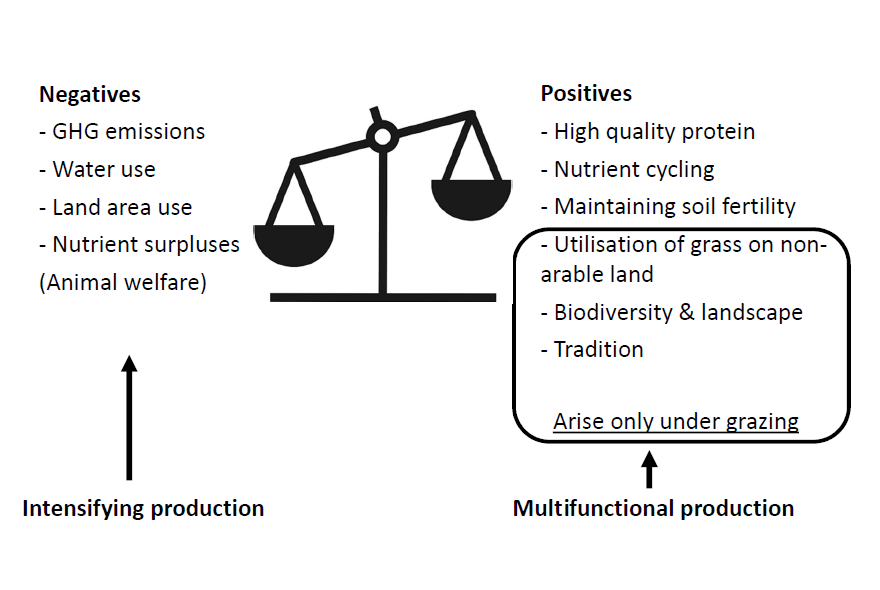There has been a lot of heated debate about the production and consumption of meat, milk and other animal-derived products. The arguments are conflicting: promoting vegetarianism to save the planet versus the crucial role of cattle in Finnish agriculture, taking beef off the menu in the UniCafe versus “cow-is-yes“-tags by producers, fate of forlorn calves on a grated floor versus “happy cows” saving traditional landscapes and endangered species. As response to the critique, the major retailers (such as Valio, Atria and Arla) have multiplied their efforts to reduce the environmental impacts their production creates.
Have we missed something? Yes! A holistic and rational outlook on the possibilities and limitations associated with the use of animals in agriculture appears to be missing.
The hard facts are crystal clear – even the most efficient production of animal-derived protein loses in comparison with plant-derived protein on several key environmental criteria, namely land, water and energy usage. Fundamentally, this derives from the laws of physics: the higher up the food chain you go, the larger the energy loss. Advanced technology and agronomy are not going to vaporise this negative side of animal husbandry.

Nonetheless, animal husbandry has a number of important benefits, which can potentially balance the downsides within certain production limits. The key ones comprise: 1) the ability of animals to convert non-edibles into high-quality food: ruminants can digest grass and monogastric animals (pigs, poultry) can live on wastes; 2) thanks to ruminants, a farm keeps grassland in crop rotation, which provides a number of agronomic benefits, 3) animals produce manure that is a valuable fertiliser for arable land, and 4) animals support the biodiversity of farmland.
However, the above benefits come true only if certain conditions are met. Farmland species benefit from the presence of domestic animals only when the latter are on a pasture, not locked indoors. Unique biodiversity is maintained only on grazed or mown semi-natural grasslands, not on heavily grazed or repeatedly mown cultivated silage fields. Manure adds value to overall food production if at least some of it is used on crops going into human mouths rather cows’: that is, used entirely on silage and pasture and thus cycled within animal farms and animal-dominated regions. Therefore, the real issue is the re-designing of farming systems to maximise the benefits of having domesticated animals, rather than to green the corners of a production that is, ultimately, environmentally problematic. If we continue to compare the environmental impacts of different products using single indicators, such as CO2 emissions per kg of produced food, we will end up ignoring the very need for having animals in agriculture.
The existing literature suggests several concepts that would justify having animals in production. The premises are simple:
- Arable land should be used primarily for the production of plant-based food for humans.
- Animals should be fed biomass that is not suitable for or not wanted by humans.
- Other valuable outputs of animals, such as manure, should be used as much as possible for crops that are for human consumption.
- Extensive low-productivity grazing should be used only when it can be justified by reasons other than meat and milk production, such as biodiversity, fire control, or livelihoods of vulnerable populations.
So far so good, but we have a glaring lack of specific evidence on what the above would mean for farms’ set-up as well as diets, though some research started to emerge in the recent years. As for Finland, to what degree does our production correspond to the above?
We know that grasses comprise only about half of total feed used for cattle. What ratio of grass to other forage in cattle diets would produce the balance of positives against negatives? How much grassland on a farm level do we need to maintain soil fertility even without animals? Furthermore, we know that both an increase of grass share in a cow’s diet and an increase in grazing reduce the milk yield and hence the efficiency per cow. Yet both maintain biodiversity and reduce competition for arable land, resulting in increased land use efficiency on the landscape level. How much grazing and of what kind would suffice to support currently declining farmland biodiversity?
To continue further, the current production form that separates animals and crops to different farms and even regions cannot truly utilise the benefits offered by manure. To what extent should an animal farm’s production include also production of human food (traditional mixed farming), instead of using the land, manure and rotational grassland completely for growing only animals?
Finally, how much animal-derived food is sufficient to supply a healthy diet for Finland’s population? Should the resulting overproduction be either cut back or turned into exports? What are the possible alternatives for producers’ to obtain sufficient income in the countryside if the animal production is reduced?
Our key message is that the way forward in meat and dairy production is not to focus on minimising their negative impacts such as greenhouse gas emissions, individually. We argue for shifting attention towards finding a balance between increasing the benefits of animal husbandry and keeping the downsides as low as feasible. This will likely need re-design of farming systems and may mean reduction in the overall animal farming. However, unless we take such a holistic approach, all animal farming will sooner or later be replaced by meat and milk substitutes, as they already reach lower levels of negative environmental effects (to read more about this topic, see a previous blog post here).
Authors
Irina Herzon is university lecturer in the Department of Agricultural Sciences, member of Helsinki Institute of Sustainability Science (HELSUS), University of Helsinki.
Kari Koppelmäki is a doctoral student in agroecology, University of Helsinki.
Sirpa Kurppa is a research prof. emerita, Natural Resources Institute Finland (Luke).
References and further reading
Fairlie S. 2010. Meat: A Benign Extravagance. Permanent Publications, The UK. 322 p. (available in as e-book form)
Röös et al. 2017. Greedy or needy? Land use and climate impacts of food in 2050 under different livestock futures. Global Environmental Change. (available here)
Photo by: Iryna Herzon
